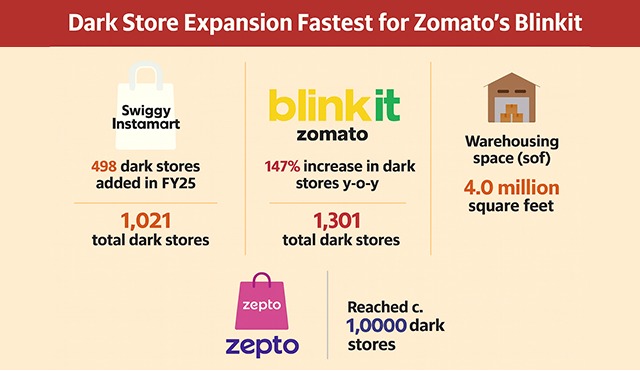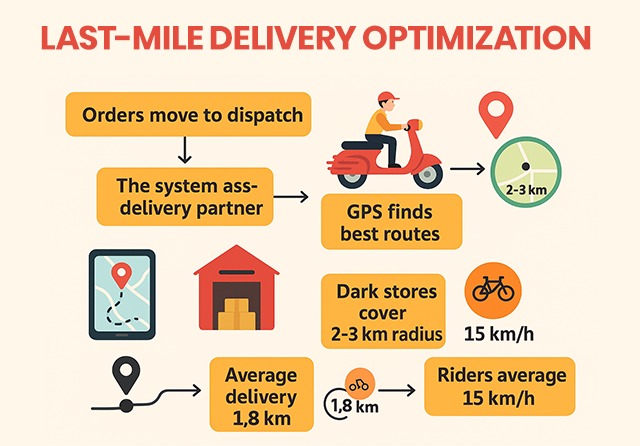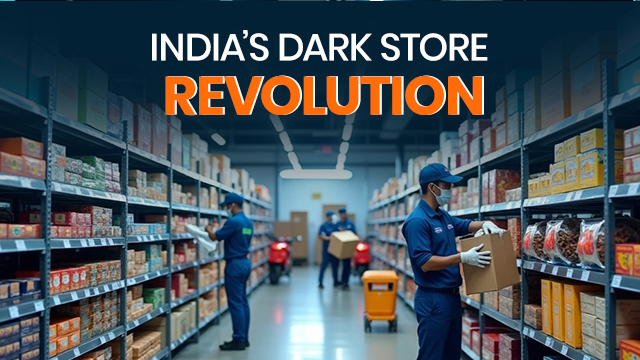Dark stores are changing India’s retail world at an unprecedented pace. The quick commerce market will reach an estimated USD 5.3 billion by 2025. Projections show further growth to USD 12.59 billion by 2030—reflecting a CAGR of 18.9%. This remarkable growth stems from careful planning and execution.
A massive infrastructure buildout powers this transformation of urban Indian shopping habits. Swiggy’s Instamart added 498 dark stores in FY25 alone, which almost equals its total openings over the previous four years. Zomato’s Blinkit grew its store count by 147% year-on-year to 1,301 locations. These specialized mini-warehouses serve one purpose: they deliver everything from daily essentials to festive gifts in minutes instead of days.
Traditional retail has felt the profound effects of this shift. Quick commerce drives much of incremental sales in metros. Urban consumers now divert 25% of their grocery spending from neighborhood kiranas. This piece takes a closer look at how these dark store operations deliver on their 10-minute promises. We’ll explore their discount strategies and analyze how they alter both consumer expectations and India’s retail economy.
What is a Dark Store and Why It Matters
Dark stores serve only as fulfillment centers for online orders. These retail outlets stay closed to public foot traffic and work as mini distribution centers strategically placed throughout urban areas.
How dark stores differ from traditional retail
Dark stores and conventional retail spaces have stark differences. Traditional shops create attractive displays and checkout counters to enhance customer experience. Dark stores completely remove these elements. Their interior layout looks like regular supermarkets with aisles and shelves, but you won’t find any promotional signage. The focus stays on optimization – with staff members called “pickers” who work 24/7 to complete orders shown on tablet computers attached to shopping trolleys.
Dark stores also cut costs significantly. They run at nearly £6 (approximately ₹630) less per grocery order compared to picking items at traditional stores. This comes from their optimized layouts and no need for customer service staff.
The rise of dark stores in India’s quick commerce boom

Quick commerce in India has seen dark stores expand rapidly. Swiggy’s Instamart added 498 dark stores in FY25 alone—a number almost equal to its total openings in the previous four years. The company’s network now covers 1,021 stores across four million square feet.
Zomato’s Blinkit grew even faster, with its store count jumping 147% year-on-year to 1,301 locations. The company’s warehousing space expanded to 5.2 million square feet. Zepto, another key player, stopped expanding after reaching about 1,000 stores.
Why urban areas are ideal for dark store setups
Urban centers create the perfect environment for dark store operations. Large populations in these areas drive high order volumes that enable quick fulfillment. Cities like Mumbai, Delhi, and Bengaluru lead this change because of their dense populations and strong demand for convenient shopping.
Multiple dark stores placed close to high-order-density areas create hyperlocal delivery networks. This strategy has reduced average metro trip lengths by 20-30% in the last year. The result is lower delivery costs and the ability to keep those 10-minute delivery promises that define quick commerce.
How 10-Minute Deliveries Actually Work
Quick commerce apps deliver orders in 10 minutes through a sophisticated blend of technology, people, and logistics. Your order triggers a chain of precisely coordinated operations the moment you tap that purchase button.
Order routing and inventory mapping
A centralized system automatically sends your order to the nearest dark store through specialized management software. The platforms check product availability and store locations before assigning orders to pickers. Dark stores track their inventory live to guarantee products shown are ready for delivery. These facilities stock just 2,000-2,500 popular items and focus on essentials rather than variety.
Role of technology in fast fulfillment
Advanced Warehouse Management Systems (WMS) serve as the foundation of quick commerce and provide live visibility into stock levels and processing. Smart algorithms analyze buying patterns, seasonal trends, and customer behavior to maintain optimal inventory. Dark stores arrange their stock strategically. High-demand products sit closest to packing areas, while items follow logical sections for quick picking. This smart layout helps staff collect orders in just 60 seconds.
Staffing and picker efficiency
The core team watches dashboards that display active orders inside each dark store. Handheld devices guide pickers through optimized routes once they receive an order. A typical order has six SKUs and takes just 90 seconds to pick, pack, and bill. Team members receive specialized training for each fulfillment step to boost accuracy and output. Advanced facilities use batch picking where staff handle multiple orders at once to streamline processes.
Last-mile delivery optimization
Orders move to dispatch where the system assigns the nearest available delivery partner. GPS systems find the best routes by factoring in traffic, weather, and delivery points. Dark stores cover a delivery radius of 2-3 kilometers. The average delivery distance stays around 1.8 km, which makes the 10-minute delivery target possible. Zepto mentions their riders maintain 15 kmph on average without facing penalties for late deliveries.

Gifts, Discounts, and the New Consumer Experience
Dark store operations are changing festive season shopping habits faster across India. People now choose between rushing to physical markets and getting instant deliveries from specialized platforms.
How festive gifts are driving seasonal demand
Quick commerce platforms started their festive preparations months ago. They saw demand spikes during celebrations like Janmashtami. Instamart and others now sell more than just daily essentials. Their catalog includes eco-friendly Ganpati idols, modaks, pookalam flower selections for Onam, and premium brand gold and silver coins for Dhanteras shoppers. Chocolates, namkeens, and salty snacks sales are rising a lot during festive seasons.
Discount strategies used by dark store platforms
Dark stores keep customers coming back with aggressive discounts and loyalty programs. Customers get free products, no delivery charges, special discounts, and cashback rewards. Many platforms still give deep discounts that make small purchases cheaper than regular e-commerce. This approach has pulled low-value purchases away from regular online stores. The average quick commerce basket now costs around ₹600.
The psychology of instant gratification
Quick commerce thrives on people’s desire to get things right away. Today’s shoppers put convenience first. Studies show 88% of buyers will pay extra to get items the same day or faster. About 41% don’t mind paying more for same-day delivery. Another 24% will pay even more to get items within one or two hours. This mindset affects how people make impulse purchases. When products arrive in minutes, spontaneous buying goes up by a lot.
How consumer loyalty is changing to quick commerce
Speed now determines where people shop. Research shows 39% of shoppers will switch to different brands just to get faster delivery. People don’t stock up at supermarkets like before. They buy less but more often through quick commerce. These platforms’ success has raised customer expectations everywhere. They now just need similar speed from pharmacies, electronics stores, and beauty shops.
The Bigger Picture: Impact on Retail and Local Economy
Quick commerce platforms are expanding rapidly and causing major disruption to India’s traditional retail landscape. Around 200,000 kiranas have shut down – 45% in metros, 30% in Tier-1 cities, and 25% in Tier-2/3 cities. Urban kiranas that remain open have seen their sales drop by 10-30%, and customer visits have reduced by half compared to previous years.
How kiranas are adapting or losing ground
Some kiranas are trying to survive by becoming dark stores for platforms like Zepto. Others have joined digital platforms such as PayNearby and KiranaPro to offer online ordering and delivery services. In spite of that, kiranas that rent shop space struggle to make enough profit after paying high rents.
Real estate shifts driven by dark store demand
Dark stores have altered the map of India’s real estate market. Dark store space demand reached 24 million square feet in 2023. Experts project this will grow at 12% CAGR to 37.6 million square feet by 2027. Property prices are “going through the roof” in both Tier-I and Tier-II cities. Monthly rental values range from ₹40 to ₹200 per square foot, with Delhi having the highest rates.
Job creation vs. gig economy instability
Quick commerce platforms will create over 4 lakh jobs by March 2025 – a 60% jump from current numbers. But this growth comes with serious drawbacks. The gig economy lacks job security and benefits because workers are labeled as “independent contractors” instead of employees. The sector will grow to INR 155,850.69 billion by 2032, yet gig workers face economic uncertainty and irregular work options.
Regulatory and sustainability concerns
Quick commerce’s disruption of traditional retail has caught regulators’ attention. These platforms work in regulatory gray areas and often present themselves as technology companies to avoid retail rules. States like Karnataka and Rajasthan have created laws to protect gig workers’ rights. Environmental issues have also surfaced as quick commerce operations create lots of single-use plastic waste. Food safety authorities now conduct more inspections after they found hygiene violations in many dark stores.
Conclusion
Dark stores have revolutionized India’s retail world. These specialized mini-warehouses make 10-minute delivery promises possible through advanced technology and hyperlocal logistics networks. Consumer behavior continues to change as people welcome the convenience of instant gratification.
This retail revolution brings tremendous convenience at a heavy cost to traditional retail. Local kiranas struggle to survive, and thousands have closed their doors in cities of all sizes. Notwithstanding that, store owners can still adapt by switching to digital operations or joining forces with platforms that disrupt their business model.
Dark stores alter urban economies by creating jobs, changing consumption patterns, and driving real estate prices. The sector’s rapid growth raises concerns about worker protections and environmental sustainability. Regulatory systems cannot keep pace with these changes, which creates uncertainty for everyone involved.
Quick commerce means more than faster deliveries. This radical alteration changes how consumers, retailers, and urban spaces interact. Quick commerce platforms aggressively expand their reach, which raises questions about whether 10-minute deliveries justify such widespread economic and social changes.
India’s dark store boom offers clear benefits through speed and accessibility. The effects on retail diversity, urban planning, and economic stability remain uncertain. Indian retail’s future depends on traditional businesses adapting to new realities while platforms balance their growth with sustainability and social responsibility.
FAQs
A dark store is a mini-warehouse that stays closed to shoppers and serves only as a fulfilment centre for online orders. Built for speed and efficiency, these stores make it possible for quick commerce platforms to deliver essentials and gifts within minutes.
They combine live inventory mapping, optimised layouts, trained pickers, and hyperlocal placement within 2–3 km of customers. Orders are routed automatically, picked in 60–90 seconds, and dispatched to nearby riders with GPS-guided routes.
Swiggy Instamart, Blinkit (Zomato), and Zepto are the main players. Together they have built thousands of dark stores across metros, scaling millions of square feet of warehousing to meet surging demand.
High population density and concentrated demand allow platforms to process large volumes in small radii. This reduces delivery distances by up to 30% and makes 10-minute service economically viable in cities like Delhi, Mumbai, and Bengaluru.
Speed has become a deciding factor in shopping. Consumers now make more frequent, smaller purchases and are willing to switch brands for faster delivery. Festive shopping has shifted online too, with instant access to gifts, food, and seasonal items.
Quick commerce has diverted up to 25% of grocery spending in metros away from kiranas. Around 200,000 kiranas have shut down, while others adapt by partnering with delivery platforms or joining aggregator services.
While dark stores create jobs and convenience, they also raise concerns about gig worker security, rising real estate costs, and sustainability issues like plastic waste. Regulators are only beginning to address these challenges.

Leave a Reply